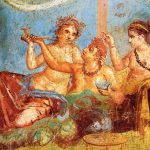Magic is always known to be at odds with science. One believes in the truth, while the other bends it. However sometimes, magic and science find themselves on the same side.
Years ago, certain Roman, and other latin and greek speaking communities believed in practices from the Mithraic religion. In specific, many documented and created various spells and curses which served a multitude of purposes, from putting your enemies to sleep to making your friend fall in love. Majority of these spells recorded and later translated to English in the PGM (The Greek Magical Papyri) utilized herbs such as Mandarake and Rue, which often have been seen to serve a purpose in modern medicine. This article analyzes the effectiveness of various spells, by comparing the use of the herbs in their spells to their researched chemical properties and modern applications. Thus suggesting that perhaps ancient magic was much more than a creative pastime.
Below are several spells taken from the PGM whose magical ingredients hold a similar function in modern science:
“Hail, hail, ABLY, O golden cup of Osiris! / From you have drunk Isis, Osiris, and the great Agathodaimon.”
The three gods drank and after them I myself drank in order that you will not let me get drunk, you will not let me list, you will not make me fall, you will not make me be thrown down, you will not make me be troubled of heart, you will not mouth curse. May I be healed of all poison, pus, [and] venom. They shall be removed from my heart. When I drink you, may I vomit them up in her name of SABRA BRIATHA, the daughter/ of the Agathodaimon,” for I am SABRA BRIATHA.
HER is my name. I am Horus SHARON from receiving greetings. AHO, the child, is my name, being my real name.” (PGM 471)
This spell that claims to extract the venom from the heart of man who has already been poisoned, Rue is necessary. Rue has extensively been used in the modern field of medicine to invoke vomiting, aid in indigestion, and create anti-inflammatory responses, and if combined with something such as wine, can react in the stomach in such a way that it creates vomiting. The flavonoids in rue will also help partially cleanse the blood stream of the individual. Its coumarins allow the Rue to counteract swelling in the body as well as the inflammation or redness. Thus as a result of these processes, rue can help remove some poisons from the body and will reduce pain, making it a good herb to counteract the effects of bites. Its antioxidant properties can also allow it to repel some major diseases, making this spell likely extremely effective at negating the effects of poison. The surprising use of Rue in the spell suggests that ancient magic may have been an effective method of curing poison, closing the gap between science and magic.
Aside from Rue, Mandrake is also a commonly used herb in the Mithraic spells. In fact it made multiple appearances in the PGM, specifically in spells that induce sleep. Such uses align with its modern medical uses in drugs that allow for deep sleep, or numbness. One spell reads:
“Another, if you wish to make a man sleep for two days: mandrake root, 1 ounce; water and honey, I ounce; henbane, 1 ounce / ivy, 1 ounce. You should grind them with a lok-measure of wine. If you wish to do it cleverly, you should put four portions to each one of them with a glass of wine; you should moisten them from morning to evening; you should moisten them from morning to evening; you should clarify them; and you should make them drink it. [It is] very good.” (PGM 716 -724)
The various components of Mandrake, such as its hyoscyamine and scopolamine allow the body to engage into a deep sleep. Both Hyoscyamine and Scopolamine contain several antispasmodic properties as well as anticholinergic properties. These properties allow Mandrake to be an effective sedative herb as well as an anti-inflammatory agent. The result of such properties make it helpful in creating sleep potions and spells such as those referenced in the PGM. Once again suggesting that ancient magic may have been an effective medicinal practice in years prior.
Although existing centuries ago, these ancient spells’ use of various herbs that serve similar purposes in modern medicine simply reveal the intelligence and accuracy of the ancient cultures. While we may have more advanced technology, there is still a lot we can learn from our past, even if it is in another language. Overall, finding connections between magic and science can allow us to further our current medical knowledge and increase cultural appreciation for ancient magic.







